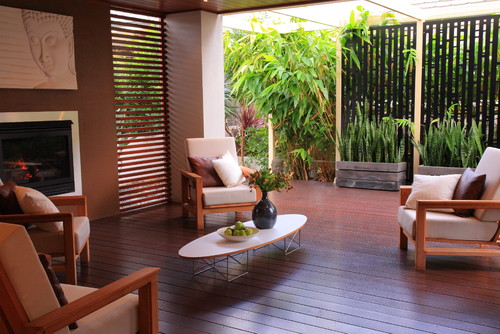It is sometime incorporated in building design as part of building space especially in large building or residential building (purposely called courtyard house). This chapter however will relatively not discuss on these types of courtyards, but will focus on one more topic called Courtyard In Home which is thought interesting to be elaborate.
Mediterranean Exterior design by New York Architect David Howell Design
Courtyard in huge building is common. Courtyard house also well-known as specially designed with courtyard, probably due to either the size of the house or the concept itself. For normal house like single detached (huge or small), semi detached or terrace, there are no space allocated for courtyard purpose (Malaysia context).
Courtyard in huge building is common. Courtyard house also well-known as specially designed with courtyard, probably due to either the size of the house or the concept itself. For normal house like single detached (huge or small), semi detached or terrace, there are no space allocated for courtyard purpose (Malaysia context).

Why courtyard is important to be part of home internal space and how can it function and provide better living to the household?
More and more, architects are investigating ways that courtyards can play a role in the development of today's homes and cities. In densely populated areas, a courtyard in a home can provide privacy for a family, a break from the frantic pace of everyday life, and a safe place for children to play. With space at a premium, architects are experimenting with courtyards as a way to provide outdoor space for small communities of people at a time. (source: Wikipedia)
Courtyard homes are more prevalent in temperate climates, as an open central court can be an important aid to cooling house in warm weather. However, courtyard houses have been found in harsher climates as well for centuries. The comforts offered by a courtyard—air, light, privacy, security, and tranquility—are properties nearly universally desired in human housing. (source: Wikipedia)
Courtyard Functions
1. Secured open to sky indoor space
2. Source of natural lighting to inner spaces (light well)
3. Promotes cross natural ventilation throughout the house (ventilation shaft)
4. Private open space for family gathering and activity
5. Children playing space

6. Landscaping space
7. Transition space (public to private)
8. Feature space and focal point
9. Intimate / therapeutic space
Type of Courtyard
1. A yard (atrium/void) in the centre of the dwelling.
2. A colonnaded yard (peristyle) ornamented (normally used as an outdoor living and dining space)
3. A horticultural space (xystus) was used for flowers and vegetables and might be decorated with statues, a pavilion and water features.
Courtyard Components
1. Paving (stone, brick, pebbles etc.)
2. Lawn (natural grass or artificial)
3. Water elements (water feature,fountain, swimming pool, fish pond etc.)
4. Landscaping (shrubs, ornament trees, indoor trees, artificial trees)
5. Feature wall (stone, brick, rock, pebbles, etc.)
Contemporary Patio design by San Francisco Landscape Architect Randy Thueme Design Inc. - Landscape Architecture
6. Decking (timber deck)Advantage(s)
Courtyard very much contributes to sustainability of a house as well as enhancing the look of the internal space. Indoor air quality and energy saving will increased. Interaction with environment can be happen from inside of house. Rainwater can be harvested and collected to a pond in courtyard area or channeled through courtyard to drain off. Courtyard can also be designed to contain rain water before used for landscape watering.
Disadvantage(s)
Although courtyard is open to the sky on the roof, security factor also need to be considered especially during night time. Opening to the courtyard have to be closed whenever the occupant leave the house or at night. All the elements like pond, landscaping and etc. need to be ensured properly maintained to keep continuous neat and clean as it is part of indoor space.












No comments:
Post a Comment